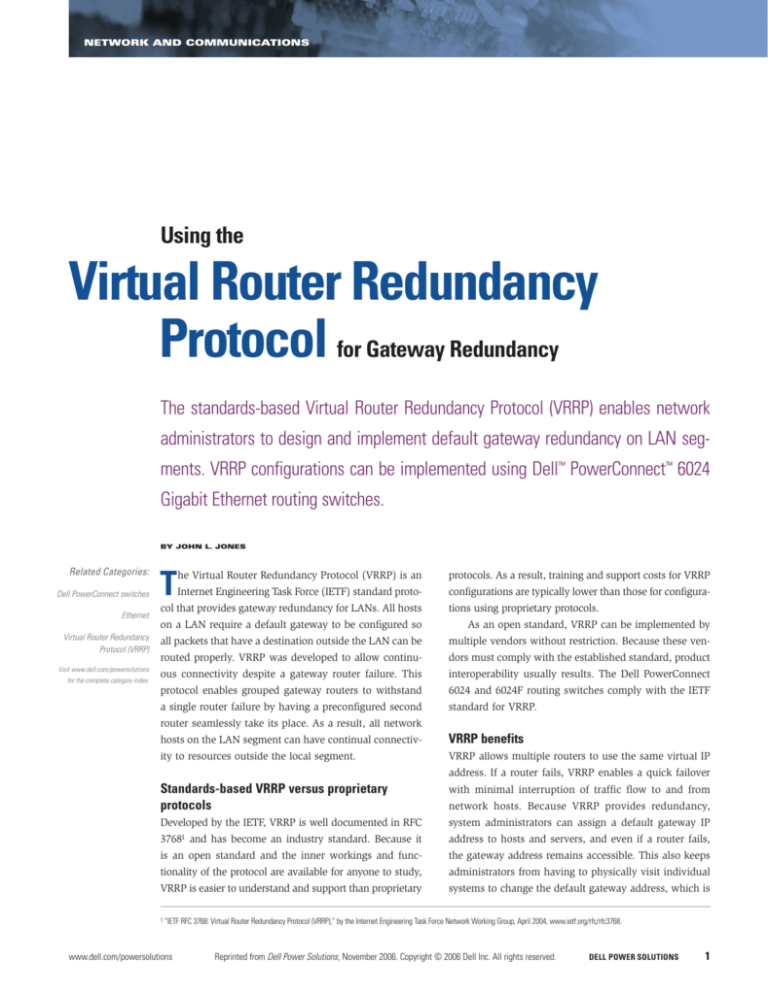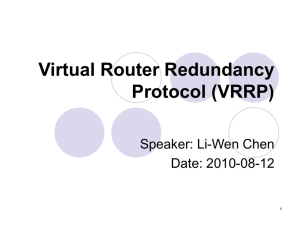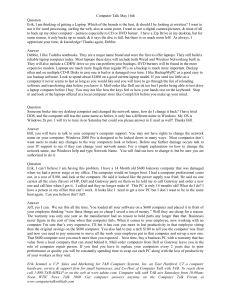
NETWORK AND COMMUNICATIONS
Using the
Virtual Router Redundancy
Protocol for Gateway Redundancy
The standards-based Virtual Router Redundancy Protocol (VRRP) enables network
administrators to design and implement default gateway redundancy on LAN segments. VRRP configurations can be implemented using Dell™ PowerConnect™ 6024
Gigabit Ethernet routing switches.
BY JOHN L. JONES
Related Categories:
Dell PowerConnect switches
Ethernet
Virtual Router Redundancy
Protocol (VRRP)
Visit www.dell.com/powersolutions
for the complete category index.
T
he Virtual Router Redundancy Protocol (VRRP) is an
protocols. As a result, training and support costs for VRRP
Internet Engineering Task Force (IETF) standard proto-
configurations are typically lower than those for configura-
col that provides gateway redundancy for LANs. All hosts
tions using proprietary protocols.
on a LAN require a default gateway to be configured so
As an open standard, VRRP can be implemented by
all packets that have a destination outside the LAN can be
multiple vendors without restriction. Because these ven-
routed properly. VRRP was developed to allow continu-
dors must comply with the established standard, product
ous connectivity despite a gateway router failure. This
interoperability usually results. The Dell PowerConnect
protocol enables grouped gateway routers to withstand
6024 and 6024F routing switches comply with the IETF
a single router failure by having a preconfigured second
standard for VRRP.
router seamlessly take its place. As a result, all network
hosts on the LAN segment can have continual connectiv-
VRRP benefits
ity to resources outside the local segment.
VRRP allows multiple routers to use the same virtual IP
address. If a router fails, VRRP enables a quick failover
Standards-based VRRP versus proprietary
protocols
network hosts. Because VRRP provides redundancy,
Developed by the IETF, VRRP is well documented in RFC
system administrators can assign a default gateway IP
37681
address to hosts and servers, and even if a router fails,
and has become an industry standard. Because it
with minimal interruption of traffic flow to and from
is an open standard and the inner workings and func-
the gateway address remains accessible. This also keeps
tionality of the protocol are available for anyone to study,
administrators from having to physically visit individual
VRRP is easier to understand and support than proprietary
systems to change the default gateway address, which is
1 “IETF RFC 3768: Virtual Router Redundancy Protocol (VRRP),” by the Internet Engineering Task Force Network Working Group, April 2004, www.ietf.org/rfc/rfc3768.
www.dell.com/powersolutions
Reprinted from Dell Power Solutions, November 2006. Copyright © 2006 Dell Inc. All rights reserved.
DELL POWER SOLUTIONS
1
NETWORK AND COMMUNICATIONS
172.16.0.1
it is configurable) using the multicast address 224.0.0.18 (the
172.16.0.201
multicast address assigned to VRRP routers). When three heart-
X
beats are missed, the backup router becomes the master.
LAN segment
The role of VRRP in an enterprise environment is illustrated
Host A
Host B
Host C
Host D
in Figures 1–4. In the example environment shown in Figure 1,
all hosts have the IP address 172.16.0.1 configured as the default
gateway address on the LAN segment. If the gateway router fails,
Default gateway for all hosts is 172.16.0.1
connectivity to hosts or servers outside this segment also fails.
Two gateway routers: Active/passive
Figure 2 shows two gateway routers in an active/passive configuration
required when a gateway fails. Remote access becomes impossible
for VRRP. Even though they have different IP addresses assigned to
their network interfaces attached to this LAN segment, they have both
without network connectivity through gateway routers.
Another benefit of the redundancy that VRRP provides is that
been given a VRID in the form of a locally reached IP address. This
system administrators can include a default gateway IP address as a
address may be the same as one of the gateway router’s addresses.
Dynamic Host Configuration Protocol (DHCP) option on their DHCP
In this example, the routers have been assigned roles of master
server, and this address will not change. Therefore, reconfiguration of
(active) and backup (passive). The master router is the gateway
DHCP servers is not necessary when a gateway router failure occurs.
through which all traffic flows in and out of the segment. The
backup router remains in a standby mode until the master fails.
Components of a VRRP configuration
VRRP uses the following components to create virtual router
Two gateway routers: Active/active
redundancy:
To use the second gateway router and thus avoid stagnant hardware,
administrators can provide each router with a VRID for an active/
•
•
VRID: VRRP uses a common virtual router identification
active configuration (see Figure 3). This provides two default gate-
(VRID) number to group the gateway routers. The number is
ways to the LAN segment. The hosts on the network can be divided
arbitrary and can range from 1 to 255. Each VRID group has
into two groups, and each group assigned its own default gateway
its own unique VRID number.
address. Each gateway address correlates to a different VRID, and
Master router: The VRRP router controlling the IP address
the traffic is divided between the two gateway routers, resulting in
associated with the virtual router group is called the master.
load balancing. Along with load balancing, benefits of this configu-
It answers Address Resolution Protocol (ARP) requests and
ration include full router redundancy and full device usage.
forwards traffic for the network segment. If the IP address of
•
the virtual router group and an interface in the VRRP group
Three gateway routers
match, VRRP automatically selects that router to become the
The next scenario, shown in Figure 4, provides additional redun-
master if not configured statically.
dancy to the gateway router group. This configuration is similar to
Backup router: The backup router remains available, ready to
the one shown in Figure 3, except a third router is used as a backup
assume the role of master should the current master fail. The
router for each VRID group. No traffic is sent through the backup
master and backup communicate via heartbeat messages sent
172.16.0.1
by the master once every second (this is the default interval;
172.16.0.1
172.16.0.201
Master
Backup
Master
Backup
VRID 1: 172.16.0.1
172.16.0.201
Master
Backup
VRID 1:
172.16.0.1
VRID 201:
172.16.0.201
Host A
Host B
Host C
Host D
Default gateway for all hosts is 172.16.0.1
Figure 2. LAN using two gateway routers in an active/passive configuration
2
DELL POWER SOLUTIONS
Host A
Host B
Default gateway
172.16.0.1
Host D
Host C
Default gateway
172.16.0.201
Figure 3. LAN using two gateway routers in an active/active configuration
Reprinted from Dell Power Solutions, November 2006. Copyright © 2006 Dell Inc. All rights reserved.
November 2006
NETWORK AND COMMUNICATIONS
172.16.0.211
172.16.0.1
172.16.0.201
VRRP also allows definition of the advertisement interval,
Master
Master
Backup
or heartbeat, between the routers. The default value is one
second, which allows for rapid failover, but this can be changed
Backup
if desired. All virtual routers must have the same timer value
VRID 201:
172.16.0.201
VRID 1:
172.16.0.1
Host B
Host A
for the heartbeat:
Host C
Host D
switch-1(config-if)# vrrp 10 timer 2
Finally, administrators can activate the VRRP configuration on
Default gateway
172.16.0.1
Default gateway
172.16.0.201
Figure 4. LAN using three gateway routers
router unless one of the master routers fails. This provides full
redundancy for the master routers, although the backup router may
the router with the up option:
switch-1(config-if)# vrrp 10 up
At this point, half of the configuration is complete. An informational message similar to the following should appear:
become overloaded if both master routers fail at the same time.
1-Jan-2006 1:01:00 %VRRP-W-BCKMSTR: VRRP router
Steps for setting up a VRRP configuration
with id 10 and masterIpAddr 172.16.0.1 became
VRRP configurations can use a single VRID or multiple VRIDs. This
a master
section outlines the steps administrators can take to configure the
master gateway router and the backup router for single- or multiple-
Configuring the backup router
VRID environments as well as commands for saving and verifying
Figure 5 shows commands for configuring the backup router. The
VRRP configurations.
priority and preempt options are not needed because the master
has been defined on another router. The backup router has the default
Configuring the master router
priority value of 100 if no value is defined. A third and fourth
Administrators should enter the interface configuration mode for
backup router can be defined using the priority values, if desired.
the interface running VRRP. Note that an IP address must first be
defined on the interface before VRRP is configured:
Configuring multiple VRIDs
When configuring multiple VRIDs for full gateway redundancy,
switch-1(config)# interface ethernet g1
both routers can be configured with dual roles. For instance, the
switch-1(config-if)# ip address 172.16.0.1 /16
master for one VRID can be the backup for a second VRID. This
way, both gateway routers are used. Both configurations can use
To configure VRRP on the interface, administrators must first
the same interfaces, different physical interfaces, or virtual LAN
define the VRID for the gateway group. This address can be (but
(VLAN) interfaces. The commands shown in Figure 6 can be used,
is not required to be) the same as the IP address for the interface:
in addition to the commands already presented, to configure another
VRID, resulting in a dual-gateway configuration.
switch-1(config-if)# vrrp 10 ip 172.16.0.1
Saving the configuration
Next, administrators should set the priority of the gateway
All of these configuration settings can be saved in the startup-config
group member. The priority determines which gateway router is
file stored in the flash memory on each switch by using the copy
the master. The priority values range from 1 to 255, with the higher
number being the master:
switch-2# configure
switch-1(config-if)# vrrp 10 priority 255
switch-2(config)# interface ethernet g1
switch-2(config-if)# ip address 172.16.0.201 /16
It is also necessary to specify whether this gateway router will
automatically regain its active status when it comes back online after
a failure. To do this, administrators can use the preempt option:
switch-1(config-if)# vrrp 10 preempt
www.dell.com/powersolutions
switch-2(config-if)# vrrp 10 ip 172.16.0.1
switch-2(config-if)# vrrp 10 timer 2
switch-2(config-if)# vrrp 10 up
Figure 5. Configuring the backup router
Reprinted from Dell Power Solutions, November 2006. Copyright © 2006 Dell Inc. All rights reserved.
DELL POWER SOLUTIONS
3
NETWORK AND COMMUNICATIONS
running-config startup-config command. This file can be
Verifying the VRRP configuration and operation
transferred and stored on a Trivial File Transfer Protocol (TFTP)
Figure 7 shows commands that can be used to verify the configura-
server for backup, restoration, and later review.2
tion and operation of VRRP on each virtual router. The show vrrp
status command shows VRID status for each virtual router on the
switch, including the IP address, current switch role, and master
switch-2(config)# interface ethernet g1
IP and Media Access Control (MAC) addresses. The show vrrp
switch-2(config-if)# ip address 192.168.0.1 /24
configuration command shows the configured VRRP settings
switch-2(config-if)# vrrp 20 ip 192.168.0.1
for each virtual router, such as the priority value, heartbeat timer,
switch-2(config-if)# vrrp 20 priority 255
preempt setting, and current status.
switch-2(config-if)# vrrp 20 preempt
switch-2(config-if)# vrrp 20 timer 5
VRRP on Dell PowerConnect 6024 switches
switch-2(config-if)# vrrp 20 up
The following additional VRRP features can be used on Dell
PowerConnect 6024 routing switches:
switch-1(config)# interface ethernet g1
switch-1(config-if)# ip address 192.168.0.201 /24
•
switch-1(config-if)# vrrp 20 ip 192.168.0.1
Authentication: A specific plain-text password can be set to
verify that each virtual router is receiving the correct heart-
switch-1(config-if)# vrrp 20 timer 5
beat messages.
switch-1(config-if)# vrrp 20 up
•
Source IP: The source IP address used for VRRP messages on
an interface can be used to control the IP and MAC addresses
that the virtual router uses to build packets and provide
responses when queried by ARP.
Figure 6. Creating a dual-VRID configuration
Enhanced gateway redundancy
for LANs
switch-1# show vrrp status
Interface VRID
Address
--------- ---- -----------
State
Master
MAC address
The Virtual Router Redundancy Protocol
---------- ------------ ------------------
can provide three or more levels of gateway
g1
10
172.16.0.1
master
172.16.0.1
00:00:5e:00:01:0a
protection and redundancy for network
g1
20
192.168.0.1
backup
192.168.0.1
00:00:5e:00:01:14
hosts and servers. When failures occur,
only minimal downtime—usually a matter
switch-1# show vrrp configuration
Interface VRID
Address
Priority Timer
Auth Preempt Source-ip State
--------- ---- ------------ -------- ----- ---- ------- --------- -----
of seconds—is typically experienced before
access to the remote network is restored.
g1
10
172.16.0.1
100
2
No
Yes
0.0.0.0
up
Furthermore, as an open standard, VRRP
g1
20
192.168.0.1
255
3
No
Yes
0.0.0.0
up
allows for multi-vendor interoperability and
low support costs.
switch-2# show vrrp status
Interface VRID
Address
--------- ---- -----------
State
Master
MAC address
---------- ------------ ------------------
g1
10
172.16.0.1
backup
172.16.0.1
00:00:5e:00:01:0a
g1
20
192.168.0.1
master
192.168.0.1
00:00:5e:00:01:14
switch-2# show vrrp configuration
Interface VRID
Address
Priority Timer
Auth Preempt Source-ip State
--------- ---- ------------ -------- ----- ---- ------- --------- ----g1
10
172.16.0.1
100
2
No
Yes
0.0.0.0
up
g1
20
192.168.0.1
255
3
No
Yes
0.0.0.0
up
John L. Jones is a senior technical trainer in
the Enterprise Training Services Group at Dell.
He specializes in IP networking, Fibre Channel
interconnects, and the Linux® OS. He holds Cisco
Certified Network Professional (CCNP) and Red
Hat Certified Engineer® (RHCE®) certifications.
F OR MORE
INF ORM ATION
Dell networking:
www.dell.com/networking
Figure 7. Verifying the VRRP configuration and operation on each virtual router
2 For more information about these configuration files, see the “Configuration and Image Files” section in the Dell PowerConnect 6024/6024F Systems CLI Reference Guide
e at support.dell.com/support/edocs/network/pc6024/en/
cli/html/configim.htm.
4
DELL POWER SOLUTIONS
Reprinted from Dell Power Solutions, November 2006. Copyright © 2006 Dell Inc. All rights reserved.
November 2006










